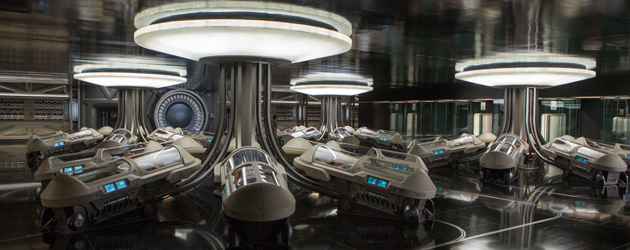Guy Hendrix Dyas 2.0

different to what you’d expect. He doesn’t draw. He doesn’t stand over your shoulder and point. He would just say, This is great but can you do anything else? He was always pushing, pushing, pushing, which is a fantastic trait in a director. He was a champion of what I was doing and I was very lucky. Tom Rothman and his team at SONY were also behind it. It’s magnificent to think that a studio will allow us to build these monstrous sets to support two actors just to get the best performance out of them. In this day and age it’s extraordinary.
AS: How important was working with the DP, Rodrigo Prieto, on the look of the sets?
GHD: Rodrigo was one of the greatest collaborators I’ve ever worked with. What I loved about working with Rodrigo was his natural good taste and finesse. His ability to see what I was doing. You need a DP to understand how beautiful these shapes are in order to put lights inside them to give you that glow. And if those lines were highlighted with light in my illustrations they were vigorously followed. Rodrigo came on a little later, as DP’s do, but I worked with him tirelessly to make sure the color and feel of the lighting was going to suit the story-points and the scenes. I’m very grateful to him for enhancing what we had done. It was just lovely to have someone with the common goal of, Let’s do something great here.
AS: How much do you normally think about lighting when your designing a movie?
GHD: It’s a huge part of what I do. That probably comes from painting and drawing. When you draw and paint you’re cognizant of where the light is coming from and what it’s doing to someone’s face, what it’s doing to a surface. In our illustrations you’ll see a strong indication of light and the color within the light, whether it’s a warm light or a cold light. I’d like to think those are inspirations for the DP when he’s lighting the set.
AS: Last we spoke you were involved in another science fiction story- a Spielberg movie titled Robopocalypse. Is that movie still in the works?
GHD: The scale of Robopocalypse was epic. What we were doing with robots was very unique. It would have been a game-changer. It was a brutal experience to leave it unfinished especially after working with someone I love like Steven, who is fantastic. Two years was a very long time for me to be out of the game. But that doesn’t happen with fast-track projects like Passengers. They stay raw and that’s the beauty of something that happens so quickly. There’s no “design-by-committee”. They happen, they come out and there’s a beautiful rawness to them.
AS: We also talked about the future of our industry last time, discussing the use of greenscreen increasing in the world of production design. This time I’d like to know if you think it will become old-fashioned to see a flat movie on a flat screen? In the future will we be in virtual environments every time, where we can look all around us in a 360 world?
GHD: God I hope that happens. I’m thrilled by immersive environments because I tend to design in a very three-dimensional way. My sets are designed for you to walk around them and explore and make discoveries. Which often you don’t get to do when you’re looking through a lens in one direction. A lot of designers say that they are only able to capture sixty-percent or forty-percent of what their sets have to offer. During actual filming you often lose the level of detail and miss the angles where you can find a sweet spot to show something off.